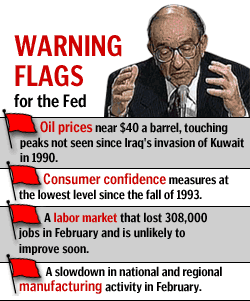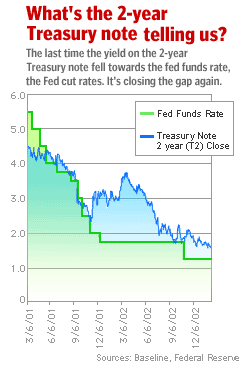NEW YORK (CNN/Money) -
The Federal Reserve wants to wait out a possible war in Iraq before it decides whether or not it needs to cut interest rates to help the economy -- but some analysts worry that the economy needs help now.
The central bank's policy-makers are scheduled to meet Tuesday to discuss short-term interest rates, which they can move lower to pump money into the economy in a bid to fend off recession and deflation.

Few economists expect the Fed to cut rates that day, but a small group of them changed their minds on March 7, when the Labor Department said U.S. employers cut 308,000 jobs from their payrolls in February, the worst job purge since the months immediately following the Sept. 11 terror attacks.
Merrill Lynch and four other firms, of the 21 polled by Reuters shortly after the jobs report, said they expected a rate cut on Tuesday, while 14 of the 21 said they thought the Fed would at least shift its stated view of the economy away from balance and towards concern about growing weakness.
"It may be that low rates are not the only help the economy needs," David Rosenberg, Merrill Lynch's chief North American economist, said in a conference call that day. "But we could be in even rougher shape without monetary ease, and 80 percent of what the Fed's already given us is behind us. We could use another dose."
Red flags for the Fed
Fed Chairman Alan Greenspan and other central bankers have been saying for weeks that they think the economy will be fine once the "geopolitical uncertainties" and higher oil prices arising from concerns about a possible U.S.-led war in Iraq are gone.
But some economists worry that the Fed is at risk of ignoring the damage already being done by pre-war conditions, including:
- skyrocketing oil prices, which cut discretionary consumer spending and weigh on corporate profits;
- plunging consumer confidence, which by two key measures is at the lowest level in about a decade;
- a labor market that's bad and only been getting worse;
- a manufacturing sector that's slowing down again, including the recent decision by automakers to cut production; and
- stock prices struggling to escape from a bear market that's lasted three years and counting.
You don't have to be John Maynard Keynes to realize that, under the weight of all these burdens, the economy's not exactly on a tear during the first quarter.
"Whenever you have a situation where inflation is not a material risk and the economy is underperforming, you should be thinking about a rate cut," said CIBC World Markets senior economist Avery Shenfeld. "There's a potential reward and not much risk."

In fact, U.S. financial markets might already be starting a drum-beat for a rate cut. The yield on the two-year Treasury bond was just above 1.5 percent on Friday -- higher than the record lows set earlier in the week, but still awfully close to the Fed's 1.25 percent target for the federal funds rate, the Fed's key short-term rate.
The spread between 10-year bond yield and the Fed funds rate has also shrunk, another sign that traders are betting that future economic weakness might need to be addressed by lower interest rates.
"There are a lot of crosscurrents now, but falling yields might indicate that demand for credit is slowing down and that the Fed, by holding the fed funds rate where it is, is actually keeping rates all along the curve from falling to their equilibrium level, or to the level where would they would more naturally go," said Northern Trust economist Paul Kasriel.
So far, the fed funds futures contract, a key indicator of market expectations about future Fed policy, thinks the chances of a March 18 rate cut are less than 20 percent. But those odds increase throughout the summer, hitting their highest point in July and August.
| Related stories
|

|
|
|
|
If the Fed is just going to cut rates anyway, why not do it now instead of later?
For one thing, money supply seems to be holding up pretty well so far, despite the Fed's inaction. And when short- and long-term rates fall on their own as they've been doing, they're pretty much helping the Fed do its job without making another big rate cut that would take the fed funds rate ever closer to zero, at which point the Fed will have to start getting creative.
And with rates already at historic lows, how much more easy credit do we really need at this point?
"The easing the Fed has already done has had a focused and limited effect, mainly on sales of homes and automobiles," said Goldman Sachs senior economist Edward McKelvey. "It's not clear another rate cut will have much effect. I think fiscal easing is more effective at this point; it more directly puts money in people's pocketbooks."
President Bush has proposed a $1.3 trillion plan of tax cuts and spending designed, in part, to help the economy. Democrats have proposed their own, much smaller, fiscal stimulus package designed to pump money directly into the economy.
Greenspan has suggested that both proposals wait until after the Iraq situation is resolved.

|

